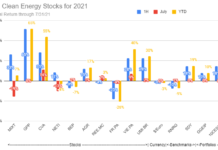David Gold
Sectors like solar, biofuels and smart grid have received a significant overweighting of venture capital investment compared to other sectors. Is this because they are better investment opportunities or because venture capitalists (VCs), being human, invest in what they know and who they know? While many entrepreneurs may not believe it, VCs are human, too.
In my last post, “Human Capital, Not Venture Capital, the Biggest Cleantech Need,” I discussed how the greatest challenge today to growing a successful early-stage cleantech business is the shortage of successful, experienced cleantech entrepreneurs. But finding the right human capital to build great cleantech businesses isn’t the only stumbling block: Human capitalists (VCs) have been limited by their own experiences and networks.
At the end of the day, venture capitalists almost always invest first in people. A great, experienced management team can make a business out of an average technology. A bad management team can destroy the most amazing of technologies. Over the past decade, as cleantech VC investment started to expand to more than a handful of specialized funds, VCs naturally turned to their business networks to learn about the sectors, identify opportunities and build management teams. Given that the largest categories of VC investments in the preceding few decades have been in software/web, semiconductors, information technology and pharmaceuticals, these are also the areas where the VCs’ largest network of experienced successful entrepreneurs resided.
As crossover entrepreneurs and crossover VCs started to explore or create opportunities, they naturally looked where their knowledge could be most applied. It should not be surprising that the lion’s share of VC investment dollars have been going into areas that have closely related technology foundations to the traditional areas of VC investment. Sectors like solar, smart grid, biofuels and LEDs have received most of the VC dollars and, as a result, increased press hype. The table below highlights the approximate portion of cleantech VC investments in some of these key areas over the past three years.
No doubt there are exciting investments to be made in these sectors. Our fund, Access Venture Partners, has invested in both an LED lighting company (TerraLUX) and a smartgrid company (Tendril Networks). But what about sectors like green building materials, industrial energy efficiency, geothermal and nuclear? They serve equally enormous markets (if not larger) and at least in some areas (if not most) have equal or greater potential impact on the economy and the environment.
Solar is a particular anomaly, receiving the single largest share of all cleantech venture capital. While sexy because of its elegance, solar is a challenged technology. The economics of solar must struggle against the triple confluence of very low efficiencies, very high costs and the fact the sun simply doesn’t shine much of the time (think night and clouds). No doubt that solar venture investments are targeted at changing those factors – except for the sun, of course. There are limits to what even VCs can accomplish. But even if the cost of solar cells dropped to zero, solar still would find itself challenged to compete with other renewables, let alone traditional energy, because at least half the system cost is outside of the cells.
Geothermal, which unlike solar can be used as “base load” (meaning that it is always on), is at the other end of the spectrum. There have been few geothermal venture capital investments, yet it has some of the most compelling economics at both the utility and home scale. I would highlight both MIT’s 2006 report on the huge potential of geothermal energy and, of more contemporary interest, the October 2009 issue of Consumer Reports, which showed how a geothermal heat pump’s potential economic return usually outperforms that of a home-based solar thermal system.
So why the VC investment preference for solar over geothermal? I’m betting that much of the bias has to do with the fact that not many VCs have strong networks of geologists, drilling technologists, heat pump engineers and steam turbine power generation experts to build great geothermal companies (myself included). While it is certainly important to be knowledgeable and comfortable with the people and technology of a company, VCs must challenge themselves to think outside their own box. If the cleantech market is going to fulfill its full business potential, VCs must push themselves beyond the normal human inclination to stick with what’s familiar. A comfortable investment may not be a great investment. Cleantech VCs need to take a peek over the side of our box. What we see and what we can learn may surprise us.
| Cleantech Segment | Traditional VC Corollary | Estimated % of Cleantech VC Investment $’s 2006-2008 |
| Solar | Semiconductors | 33%+ |
| Biofuels | Biotech | 20%+ |
| SmartGrid | Software, Web, Information Technology | 14%+ |
| LED Lighting | Semiconductors and Information Technology | 5%+ |
| Geothermal | None | <2% |
| Nuclear | None | <2% |
| Building Materials and Efficiency | None | <2% |
| Industrial Energy Efficiency | None | Not tracked… likely <2% |
Data aggregated from sources including NVCA, PriceWaterHouse Coopers MoneyTree and Greentech Media. Data from these organizations use different sources that yield different totals and each has different categories they track with cleantech funding.
David Gold is an entrepreneur and engineer with national public policy experience who heads up cleantech investments for Access Venture Partners (www.accessvp.com). This article was first published on his blog, www.greengoldblog.com.








